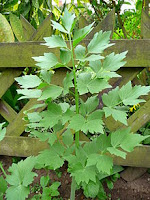Levisticum officinale
 |
| wikipedia |
 |
| wikipedia |
The homeland of the plant is unknown, but supposedly it origins from mountain woods in Central Asia or from the northern Iran. The plant can grow in altitudes of over 200 meter above sea level. Lovage is mentioned in Charlemagne's Kapitularium and was used as a kitchen herb and a medical plant since then. Today it is naturalized in many places , in Asia, North- and South America and in Europe (incl. Denmark). The monks brought the plant to Europe in the Middle Ages, and it has been cultivated in Europe for centuries, the leaves being used as an herb, the roots as a vegetable, and the seeds as a spice, especially in southern European cuisine.Lovage is an unusual spice herb since it prefers a light shadow and must have water in dry periods. Lovage was earlier cultivated in farmers gardens for livestock medicine, but today it ias a spice herb in the garden and strayed here and there. In the old days it was - not known for any reason - plant in church yards.
In modern botanical usage, both Latin forms are now used for different (but closely related) genera, with Levisticum for (culinary) lovage, and ligusticum for Scots lovage, a similar species from northern Europe, and for related species.
Folk Medicine
 |
| wikipedia |
 |
| photo: gb |
1400: water decoction against blatter stone; the juice in the eyes of a patient who was paralyzed and had lost his voice. The juice gives a pretty hair and a good scent.
Christiern Petersen 1533:beer or wine decoction for liver and spleen disorders, against roundworms , crushed seeds with beer or wine decoction from lovage, hellebore, fennel and tansy in a balm upon leprous wounds.
Henrik Smid 1546: dried and pulverized root in food for a cold stomach, promotes digestion. Wine decoction from root and seeds drives out jaundice and " the black melancholia". Crushed seeds upon bites from vipers, spiders, mad dogs, lizards and scorpions -ease the pain and drive out the poison.
A linen cloth wettened with lovage water put on a swelling of the head; face bathed with lovage water gets clear, white and pretty skin, removes red and blue spots on the body after mange and boils.
Simon Paulli 1648: crushed roots and seeds in wine for pain.
 |
| photo:gb |
1930s: A decoction was used as a refreshing drug. A doctor said (1930s) that if the Danish population used this plant all doctors would die of hunger or have to look out for another occupation.
The Pharmacopoeia states seeds and root in 1772.
 Pets: If the dog or the cat keep on placing its "cards" in an unwanted place,
then make a strong decoct of lovage and pour it on the spot, which makes
the animal go elsewhere. The dog or cat can also be washed with lovage to
avoid it getting vermins or mange.
Pets: If the dog or the cat keep on placing its "cards" in an unwanted place,
then make a strong decoct of lovage and pour it on the spot, which makes
the animal go elsewhere. The dog or cat can also be washed with lovage to
avoid it getting vermins or mange.Livestock
 |
| photo: gb |
 |
| photo: gb |
1800s: lovage was used as a preventive agent against all disease among the cattle, especially root and leaves were used for the cow's sickness A sick cow got lovage root, salt and sod cooked together into a porridge, the animal had to be beaten with a coffin key between the horn while it was eating the porridge. In spring the cows had a tuft of grass with lovage - this would keep them healthy.
In late summer the cattle had a bottle of lovage water and was smeared with tar upon the mule.
1900s: Still in 1924 is mentioned the use of lovage against foot and mouth disease. Lovage tea was used against tympania, the root was a drug for cow premature abortion.
Lovage was a part of a means for the lung- and liverdisease of the horse and against leap worms.
Lovage also used for sheep's disease.
 |
| wikipedia |
The dried and pulverized root is (like pepper) a wonderful root for preparing food. Young stems and leaves can be eaten; a couple of leaves good in the kale soup. A decoction of chopped leaves for cooked plaice and cod. Root and leaves have a strong spicy taste almost as a bouillon.
 |
| wikipedia |
Leaves, chives and dill, dried in a spice vinegar. Crushed root or plant as a spice in minced meat, sauce and sausage. The etheric oil of the root in perfume and perfumed tobaccos.
In 1942 (during WWII) a poultry slaughterhouse in Denmark used lovage for producting chicken soup - and lovage was cultivated on large areas for this purpose.
In England the young shots of the root are made into candy. Lovage is also used as a spice in the liquor industry.
 |
| photo gb |
In the times of the plague it was beneficial to hang lovage in front of the doors and keep the root in the mouth as a protection against infection. Lovage was a universel cure against witchcraft.
The plant was put under the doorstep of the stable which brought luck to the cattle and it was a protection against spell in the cattle.
A wise woman in Himmerland put lovage root and fly rowan and a note with a spell at the doorstep of a stable which brought the farmer good luck with his cattle.
 |
| wikipedia |
Source:
Brøndegaard, Folk og Flora, bd. 3, Dansk Etnobotanik 1978.
Danske Klosterurter, Anemette Olesen, 2001
Krydderurter i haven, Anemette Olesen, 1998
Wikipedia, Danish and English
photos: grethe bachmann
photos: wikipedia
No comments:
Post a Comment
Thank you for visiting my blog!